|
|
|
Sort Order |
|
|
|
Items / Page
|
|
|
|
|
|
|
| Srl | Item |
| 1 |
ID:
052297


|
|
|
|
|
| Publication |
Oct 2004.
|
| Summary/Abstract |
The use of biomass in Finland and Sweden has steadily increased over the past 25 years, up to approximately 20% of the primary energy supply in 2001. In both countries most biomass originates from forests. Forest biomass is now an integral part of modern energy systems, although primarily in industry and in the heating sector. For example, biomass accounts for 7.9% and 53% of the fuel mix in district heating in Finland and Sweden, respectively.
The general energy policy of both countries has supported biomass for energy over the entire period, although specific policies have changed with time. Research, development and demonstration has been continuously supported, and some subsidy schemes have been applied, in particular, for district heating systems (DHS) and combined heat and power. Heavy taxation of competing fossil fuels seems to have been the most effective policy instrument, although this has been directed mainly at the heat and transportation fuel markets. Electricity taxes are imposed on consumption (industry is largely exempt), and do not discriminate significantly between the sources of electricity. Starting in 2003, Sweden will have a quota-based system, a renewable portfolio standard, which is expected to increase biomass-based electricity production.
Both countries possess vast and not fully exploited biomass resources in the form of forests, and have a history of rational and large-scale forestry. Strong actors exist both with regard to forest ownership and the industrial processing of forest products. The user side, in particular, represented by DHS, can also be characterised by strong and professional management. Over time, structures have developed that facilitate an increased use of biomass for energy, for example, the forest industry infrastructure and extensive district heating. Actors within these structures have had the ability to react to policies, resulting in a stable growth in biomass use.
|
|
|
|
|
|
|
|
|
|
|
|
|
|
|
|
| 2 |
ID:
071959


|
|
|
|
|
| Publication |
New Delhi, TERI, 2006.
|
| Description |
x, 281p.
|
| Standard Number |
8179930858
|
|
|
|
|
|
|
|
|
|
|
|
Copies: C:1/I:0,R:0,Q:0
Circulation
| Accession# | Call# | Current Location | Status | Policy | Location |
| 051331 | 662.88/BHO 051331 | Main | On Shelf | General | |
|
|
|
|
| 3 |
ID:
105795


|
|
|
|
|
| Publication |
2011.
|
| Summary/Abstract |
An explorative survey was carried out on rural and semi-urban households to find out the energy consumption pattern with respect to socio-demographic and geographic factors in Bangladesh by using stratified random sampling technique. The study revealed that 100% of the households used biomass, 98% kerosene, 61% electricity, 23% LPG and 5% candle in the rural areas. In the semi-urban areas, 100% of the households used electricity, candle and natural gas, 60% kerosene and 13% petrol. Households' mean expenditure for total energy was US$ 5.34 (SE, 0.43) with total income US$ 209.84 (SE, 6.69) month-1 in the rural areas, while it was US$ 6.20 (SE, 1.35) in the semi-urban areas with the total income US$ 427.76 (SE, 24.19) month-1. This study may be a useful baseline information to energy policy makers in Bangladesh.
|
|
|
|
|
|
|
|
|
|
|
|
|
|
|
|
| 4 |
ID:
166398
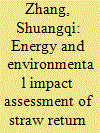

|
|
|
|
|
| Summary/Abstract |
The utilization of straw plays an important role in China's sustainable development. Returning straw to fields as organic fertilizer (straw return) and processing straw into straw briquette fuel (SBF) are two of the most promising methods for employing straw; however, there is a lack of information with respect to comparing these two methods. Therefore, a case study was conducted in Heilongjiang Province to estimate the energy and environmental impacts of straw return and the substitution of SBF for rural heating coal. This study aims to provide policymakers with useful information and to encourage rational decision-making regarding the efficient utilization of straw resources. Results showed that both straw return and substituting SBF for rural heating coal could have significant impacts on energy and the environment, while substituting SBF for rural heating coal had advantages over straw return in all aspects. Moreover, substituting SBF for rural heating coal was more acceptable to famers, and thus was easier to promote and could resolve the problem of open straw burning more effectively than straw return. Therefore, greater attention should be paid to SBF utilization, especially in rural areas. Results of this study can also benefit other regions to improve the utilization of straw resources.
|
|
|
|
|
|
|
|
|
|
|
|
|
|
|
|
| 5 |
ID:
118104
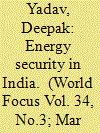

|
|
|
| 6 |
ID:
132667


|
|
|
|
|
| Publication |
2014.
|
| Summary/Abstract |
The article focuses on the interplay between two factors giving rise to friction in bioenergy governance: profound value disagreements (e.g. the prioritizing of carbon concerns like worries over GHG emissions savings over non-carbon related concerns) and regulatory complexity (in terms of regulatory measures and options). We present ethical and legal analyses of the current stalemate on bioenergy governance in the EU using two illustrative cases: liquid biofuels for transport and solid biomass-based bioenergy. The two cases disclose some similarities between these two factors, but the remaining differences may partly explain, or justify, contrasting forms of governance. While there seems to be no easy way in which the EU and national governments can deal with the multiple sustainability issues raised by bioenergy, it is argued that failure to deal explicitly with the underlying value disagreements, or to make apparent the regulatory complexity, clouds the issue of how to move forward with governance of bioenergy. We suggest that governance should be shaped with greater focus on the role of value disagreements and regulatory complexity. There is a need for more openness and transparency about such factors, and about the inherent trade-offs in bioenergy governance.
|
|
|
|
|
|
|
|
|
|
|
|
|
|
|
|
| 7 |
ID:
094837
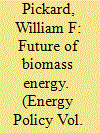

|
|
|
|
|
| Publication |
2010.
|
| Summary/Abstract |
It is argued: (i) that the harvesting of terrestrial solar radiation to perform useful work is at least an order of magnitude more efficient when carried out by solar-thermal or solar-photovoltaic processes than when carried out by way of biomass conversion and (ii) that, therefore, biomass energy is unlikely to compete successfully with inanimately harvested solar energy-except of course in restricted niche applications.
|
|
|
|
|
|
|
|
|
|
|
|
|
|
|
|
| 8 |
ID:
169735
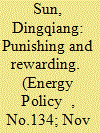

|
|
|
|
|
| Summary/Abstract |
Crop straw is the most important source of domestic energy in rural areas of many developing countries. However, as household income grows, rural residents begin to disuse crop straw, leading to a serious pollution and waste of biomass resources. This paper empirically examines the effect of public policy on crop straw use in the case of Jiangsu Province of China. Policy measures, such as burning ban and incentive programs for comprehensive use of crop straw, have important implication for rural energy supply and sustainable development of agriculture. Our results show that the burning ban has reduced crop straw burning in open field dramatically and driven farmers to retain straw into soil in sample areas. Straw retention subsidy, however, seems to play an insignificant role as the subsidy was low and not directly delivered to farmers. Moreover, crop straw markets in Jiangsu are inactive due partially to high cost of collecting and transporting crop straw, which may impose a big chanellge for straw-based energy plants that require larger scale and stable supply of crop straw. Our findings provide critical knowledge on designing and reforming current programs for crop straw management.
|
|
|
|
|
|
|
|
|
|
|
|
|
|
|
|
| 9 |
ID:
098641


|
|
|
|
|
| Publication |
2010.
|
| Summary/Abstract |
Biomass action plans in many European countries seek to expand biomass heat and fuel supply, mainly to be supplied by peripheral, agricultural regions. We develop a two-plus-ten-region energy-focused computable general equilibrium (CGE) model that acknowledges land competition in analysing the sub-state local-regional economic implications of such a strategy, embedded within a global context. Our model is based on a full cost analysis of selected biomass technologies covering a range of agricultural and forestry crops, as well as thermal insulation. The local-regional macroeconomic effects differ significantly across technologies and are governed by factors such as net labour intensity in crop production. The high land intensity of agricultural biomass products crowds out conventional agriculture, and thus lowers employment and drives up land prices and the consumer price index. The regional economic results show that net employment effects are positive for all forestry based biomass energy, and also show for which agriculture based biomass systems this is true, even when accounting for land competition. When regional consumer price development governs regional wages or when the agricultural sector is in strong enough competition to the international market, positive employment and welfare impacts vanish fully for agriculture based bio-energy.
|
|
|
|
|
|
|
|
|
|
|
|
|
|
|
|
| 10 |
ID:
132648
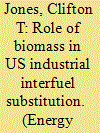

|
|
|
|
|
| Publication |
2014.
|
| Summary/Abstract |
The role of biomass in US industrial interfuel substitution in the industrial sector has typically been analyzed using data for the four traditional fuels of coal, oil, electricity and natural gas. However, the use of biomass as an industrial fuel in the US has grown, and now exceeds that of coal. Using data from 1960 to 2011, interfuel substitution in the US industrial sector is modeled with a dynamic linear logit model which includes biomass alongside the other four traditional fuels. Adding biomass to the model reduces somewhat the estimated own-price and cross-price elasticities for the other four fuels, while revealing that biomass and natural gas are substitute fuels. This implies that previous studies excluding biomass may have overestimated the potential for interfuel substitution, giving policy makers an inaccurate impression of the ability of carbon taxes or other environmental regulation to reduce greenhouse gas (GHG) emissions.
|
|
|
|
|
|
|
|
|
|
|
|
|
|
|
|
| 11 |
ID:
128050
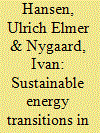

|
|
|
|
|
| Publication |
2014.
|
| Summary/Abstract |
The economic development in emerging economies in Southeast Asia has significantly increased the use of fossil fuel based energy. This has severe implications for global climate change, and against this background, scholars within the sustainable transition tradition have taken an interest in addressing how transitions towards more sustainable development pathways in this region may be achieved. This paper contributes to the abovementioned literature by examining the conducive and limiting factors for development and proliferation of a palm oil biomass waste-to-energy niche in Malaysia during the period 1990-2011. Rising oil prices, strong pressure on the palm oil industry from environmental groups, and a persisting palm oil biomass waste disposal problem in Malaysia appear to have been conducive to niche proliferation, and on top of this national renewable energy policies and large-scale donor programmes have specifically supported the utilisation of palm oil biomass waste for energy. However, in spite of this, the niche development process has only made slow progress. The paper identifies reluctant implementation of energy policy, rise in biomass resource prices, limited network formation and negative results at the niche level, as the main factors hindering niche development.
|
|
|
|
|
|
|
|
|
|
|
|
|
|
|
|
| 12 |
ID:
127867


|
|
|
|
|
| Publication |
2014.
|
| Summary/Abstract |
From a biophysical perspective, woody biomass resources are large enough to cover a substantial share of the world's primary energy consumption in 2050. However, these resources have alternative uses and their accessibility is limited, which tends to decrease their competitiveness with respect to other forms of energy. Hence, the key question of woody biomass use for energy is not the amount of resources, but rather their price. In this study we consider the question from the perspective of energy wood supply curves, which display the available amount of woody biomass for large-scale energy production at various hypothetical energy wood prices. These curves are estimated by the Global Biosphere Management Model (GLOBIOM), which is a global partial equilibrium model of forest and agricultural sectors. The global energy wood supply is estimated to be 0-23 Gm3/year (0-165 EJ/year) when energy wood prices vary in a range of 0-30$/GJ (0-216$/m3). If we add household fuelwood to energy wood, then woody biomass could satisfy 2-18% of world primary energy consumption in 2050. If primary forests are excluded from wood supply then the potential decreases up to 25%.
|
|
|
|
|
|
|
|
|
|
|
|
|
|
|
|
|
|
|
|
|